East Prussia
East Prussia (German: Ostpreußen, pronounced [ˈɔstˌpʁɔʏsn̩] (![]()
| East Prussia Ostpreußen | |||||||||||||||||
|---|---|---|---|---|---|---|---|---|---|---|---|---|---|---|---|---|---|
| Province of Prussia | |||||||||||||||||
| 1772–1829 1878–1945 | |||||||||||||||||
 Flag
 Coat of arms
| |||||||||||||||||
.svg.png) East Prussia (red), within the Kingdom of Prussia, within the German Empire, as of 1871 | |||||||||||||||||
| Capital | Königsberg | ||||||||||||||||
| Area | |||||||||||||||||
• 1905 | 36,993 km2 (14,283 sq mi) | ||||||||||||||||
| Population | |||||||||||||||||
• 1905 | 2,025,741 | ||||||||||||||||
| History | |||||||||||||||||
| 31 January 1773 | |||||||||||||||||
• Province of Prussia | 3 December 1829 | ||||||||||||||||
• Province restored | 1 April 1878 | ||||||||||||||||
| 1945 | |||||||||||||||||
| Political subdivisions | Gumbinnen Königsberg Allenstein (from 1905) West Prussia (1922–1939) Zichenau (from 1939) | ||||||||||||||||
| |||||||||||||||||
| Today part of | |||||||||||||||||
The bulk of the ancestral lands of the Baltic Old Prussians were enclosed within East Prussia. During the 13th century, the native Prussians were conquered by the crusading Teutonic Knights. After the conquest the indigenous Balts were gradually converted to Christianity. Because of Germanization and colonisation over the following centuries, Germans became the dominant ethnic group, while Masurians and Lithuanians formed minorities. From the 13th century, East Prussia was part of the monastic state of the Teutonic Knights. After the Second Peace of Thorn in 1466 it became a fief of the Kingdom of Poland. In 1525, with the Prussian Homage, the province became the Duchy of Prussia.[2] The Old Prussian language had become extinct by the 17th or early 18th century.[3]
Because the duchy was outside of the core Holy Roman Empire, the prince-electors of Brandenburg were able to proclaim themselves King beginning in 1701. After the annexation of most of western Royal Prussia in the First Partition of the Polish–Lithuanian Commonwealth in 1772, eastern (ducal) Prussia was connected by land with the rest of the Prussian state and was reorganized as a province the following year (1773). Between 1829 and 1878, the Province of East Prussia was joined with West Prussia to form the Province of Prussia.
The Kingdom of Prussia became the leading state of the German Empire after its creation in 1871. However, the Treaty of Versailles following World War I granted West Prussia to Poland and made East Prussia an exclave of Weimar Germany (the new Polish Corridor separated East Prussia from the rest of Germany), while the Memel Territory was detached and annexed by Lithuania in 1923. Following Nazi Germany's defeat in World War II in 1945, war-torn East Prussia was divided at Joseph Stalin's insistence between the Soviet Union (the Kaliningrad Oblast became part of the Russian SFSR, and the constituent counties of the Klaipėda Region in the Lithuanian SSR) and the People's Republic of Poland (the Warmian-Masurian Voivodeship).[4] The capital city Königsberg was renamed Kaliningrad in 1946. The German population of the province was largely evacuated during the war or expelled shortly afterwards in the expulsion of Germans after World War II. An estimated 300,000 (around one fifth of the population) died either in war time bombing raids, in the battles to defend the province, or through mistreatment by the Red Army.
Background
At the instigation of Duke Konrad I of Masovia, the Teutonic Knights took possession of Prussia in the 13th century and created a monastic state to administer the conquered Old Prussians. Local Old-Prussian (north) and Polish (south) toponyms were gradually Germanised. The Knights' expansionist policies, including occupation of Polish Pomerania with Gdańsk/Danzig and western Lithuania, brought them into conflict with the Kingdom of Poland and embroiled them in several wars, culminating in the Polish-Lithuanian-Teutonic War, whereby the united armies of Poland and Lithuania, defeated the Teutonic Order at the Battle of Grunwald (Tannenberg) in 1410. Its defeat was formalised in the Second Treaty of Thorn in 1466 ending the Thirteen Years' War, and leaving the former Polish region Pomerania/Pomerelia under Polish control. Together with Warmia it formed the province of Royal Prussia. Eastern Prussia remained under the Knights but as a fief of Poland. 1466 and 1525 arrangements by kings of Poland were not verified by the Holy Roman Empire, as well as the previous gains of the Teutonic Knights, were not verified.
The Teutonic Order lost eastern Prussia when Grand Master Albert of Brandenburg-Ansbach converted to Lutheranism and secularized the Prussian branch of the Teutonic Order in 1525. Albert established himself as the first duke of the Duchy of Prussia and a vassal of the Polish crown by the Prussian Homage. Walter von Cronberg, the next Grand Master, was enfeoffed with the title to Prussia after the Diet of Augsburg in 1530, but the Order never regained possession of the territory. In 1569 the Hohenzollern prince-electors of the Margraviate of Brandenburg became co-regents with Albert's son, the feeble-minded Albert Frederick.
The Administrator of Prussia, the grandmaster of the Teutonic Order Maximilian III, son of emperor Maximilian II died in 1618. When Maximilian died, Albert's line died out, and the Duchy of Prussia passed to the Electors of Brandenburg, forming Brandenburg-Prussia. Taking advantage of the Swedish invasion of Poland in 1655, and instead of fulfilling his vassal's duties towards the Polish Kingdom, by joining forces with the Swedes and subsequent treaties of Wehlau, Labiau, and Oliva, Elector and Duke Frederick William succeeded in revoking the king of Poland's sovereignty over the Duchy of Prussia in 1660. The absolutist elector also subdued the noble estates of Prussia.
History as a province
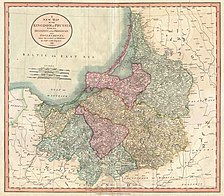
Kingdom of Prussia
Although Brandenburg was a part of the Holy Roman Empire, the Prussian lands were not within the Holy Roman Empire and were with the administration by the Teutonic Order grandmasters under jurisdiction of the Emperor. In return for supporting Emperor Leopold I in the War of the Spanish Succession, Elector Frederick III was allowed to crown himself "King in Prussia" in 1701. The new kingdom ruled by the Hohenzollern dynasty became known as the Kingdom of Prussia. The designation "Kingdom of Prussia" was gradually applied to the various lands of Brandenburg-Prussia. To differentiate from the larger entity, the former Duchy of Prussia became known as Altpreußen ("Old Prussia"), the province of Prussia, or "East Prussia".
Approximately one-third of East Prussia's population died in the plague and famine of 1709–1711,[5] including the last speakers of Old Prussian.[6] The plague, probably brought by foreign troops during the Great Northern War, killed 250,000 East Prussians, especially in the province's eastern regions. Crown Prince Frederick William I led the rebuilding of East Prussia, founding numerous towns. Thousands of Protestants expelled from the Archbishopric of Salzburg were allowed to settle in depleted East Prussia. The province was overrun by Imperial Russian troops during the Seven Years' War.
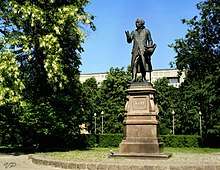
In the 1772 First Partition of Poland, the Prussian king Frederick the Great annexed neighboring Royal Prussia, i.e., the Polish voivodeships of Pomerania (Gdańsk Pomerania or Pomerelia), Malbork, Chełmno and the Prince-Bishopric of Warmia, thereby connecting his Prussian and Farther Pomeranian lands and cutting the rest of Poland from the Baltic coast. The territory of Warmia was incorporated into the lands of former Ducal Prussia, which, by administrative deed of 31 January 1773 were named East Prussia. The former Polish Pomerelian lands beyond the Vistula River together with Malbork and Chełmno Land formed the Province of West Prussia with its capital at Marienwerder (Kwidzyn). The Polish Partition Sejm ratified the cession on 30 September 1773, whereafter Frederick officially went on to call himself a King "of" Prussia.
The former Ducal Prussian districts of Eylau (Iława), Marienwerder, Riesenburg (Prabuty) and Schönberg (Szymbark) passed to West Prussia. Until the Prussian reforms of 1808, the administration in East Prussia was transferred to the General War and Finance Directorate in Berlin, represented by two local chamber departments:
- German chamber department at Königsberg with the districts of:
- Brandenburg
- Neidenburg
- Rastenburg
- Samland
- Tapiau
- Braunsberg (Ermland)
- Heilsberg (Ermland)
- Mohrungen (Ermland)
- Lithuanian chamber department at Gumbinnen (Gusev) with the districts of:
On 31 January 1773, King Frederick II announced that the newly annexed lands were to be known as the Province of West Prussia, while the former Duchy of Prussia and Warmia became the Province of East Prussia.
Napoleonic Wars

After the disastrous defeat of the Prussian Army at the Battle of Jena-Auerstedt in 1806, Napoleon occupied Berlin and had the officials of the Prussian General Directorate swear an oath of allegiance to him, while King Frederick William III and his consort Louise fled via Königsberg and the Curonian Spit to Memel. The French troops immediately took up pursuit but were delayed in the Battle of Eylau on 9 February 1807 by an East Prussian contingent under General Anton Wilhelm von L'Estocq. Napoleon had to stay at the Finckenstein Palace, but in May, after a siege of 75 days, his troops led by Marshal François Joseph Lefebvre were able to capture the city of Danzig, which had been tenaciously defended by General Count Friedrich Adolf von Kalkreuth. On 14 June, Napoleon ended the War of the Fourth Coalition with his victory at the Battle of Friedland. Frederick William and Queen Louise met with Napoleon for peace negotiations, and on 9 July the Prussian king signed the Treaty of Tilsit.
The succeeding Prussian reforms instigated by Heinrich Friedrich Karl vom und zum Stein and Karl August von Hardenberg included the implementation of an Oberlandesgericht appellation court at Königsberg, a municipal corporation, economic freedom as well as emancipation of the serfs and Jews. In the course of the Prussian restoration by the 1815 Congress of Vienna, the East Prussian territories were re-arranged in the Regierungsbezirke of Gumbinnen and Königsberg. From 1905, the southern districts of East Prussia formed the separate Regierungsbezirk of Allenstein. East and West Prussia were first united in personal union in 1824 and then merged in a real union in 1829 to form the Province of Prussia. The united province was again split into separate East and West Prussian provinces in 1878.
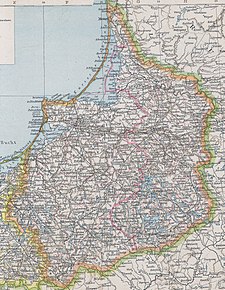
Historical ethnic and religious structure
In year 1824, shortly before its merger with West Prussia, the population of East Prussia was 1,080,000 people.[7] Of that number, according to Karl Andree, Germans were slightly more than half, while 280,000 (~26%) were ethnically Polish and 200,000 (~19%) were ethnically Lithuanian.[8] As of year 1819 there were also 20,000 strong ethnic Curonian and Latvian minorities as well as 2,400 Jews, according to Georg Hassel.[9] Similar numbers are given by August von Haxthausen in his 1839 book, with a breakdown by county.[10] However, the majority of East Prussian Polish and Lithuanian inhabitants were Lutherans, not Roman Catholics like their ethnic kinsmen across the border in the Russian Empire. Only in Southern Warmia (German: Ermland) Catholic Poles - so called Warmiaks (not to be confused with predominantly Protestant Masurians) - comprised the majority of population, numbering 26,067 people (~81%) in county Allenstein (Polish: Olsztyn) in 1837.[10] Another minority in 19th century East Prussia, were ethnically Russian Old Believers, also known as Philipponnen - their main town was Eckersdorf (Wojnowo).[11][12][13]
In year 1817, East Prussia had 796,204 Evangelical Christians, 120,123 Roman Catholics, 864 Mennonites and 2,389 Jews.[14]
German Empire
From 1824–1878, East Prussia was combined with West Prussia to form the Province of Prussia, after which they were reestablished as separate provinces. Along with the rest of the Kingdom of Prussia, East Prussia became part of the German Empire during the unification of Germany in 1871.
From 1885 to 1890 Berlin's population grew by 20%, Brandenburg and the Rhineland gained 8.5%, Westphalia 10%, while East Prussia lost 0.07% and West Prussia 0.86%. This stagnancy in population despite a high birth surplus in eastern Germany was because many people from the East Prussian countryside moved westward to seek work in the expanding industrial centres of the Ruhr Area and Berlin (see Ostflucht).
The population of the province in 1900 was 1,996,626 people, with a religious makeup of 1,698,465 Protestants, 269,196 Roman Catholics, and 13,877 Jews. The Low Prussian dialect predominated in East Prussia, although High Prussian was spoken in Warmia. The numbers of Masurians, Kursenieki and Prussian Lithuanians decreased over time due to the process of Germanization. The Polish-speaking population concentrated in the south of the province (Masuria and Warmia) and all German geographic atlases at the start of 20th century showed the southern part of East Prussia as Polish with the number of Polish-speakers estimated at the time to be 300,000.[15] Kursenieki inhabited the areas around the Curonian lagoon, while Lithuanian-speaking Prussians concentrated in the northeast in (Lithuania Minor). The Old Prussian ethnic group became completely Germanized over time and the Old Prussian language died out in the 18th century.
World War I
At the beginning of World War I, East Prussia became a theatre of war when the Russian Empire invaded the country. The Russian Army encountered at first little resistance because the bulk of the German Army had been directed towards the Western Front according to the Schlieffen Plan. Despite early success and the capture of the towns of Rastenburg and Gumbinnen, in the Battle of Tannenberg in 1914 and the Second Battle of the Masurian Lakes in 1915, the Russians were decisively defeated and forced to retreat. The Russians were followed by the German Army advancing into Russian territory.
After the Russian army's first invasion the majority of the civilian population fled westwards, while several thousand remaining civilians were deported to Russia. Treatment of civilians by both armies was mostly disciplined, although 74 civilians were killed by Russian troops in the Abschwangen massacre. The region had to be rebuilt because of damage caused by the war.
Division after 1918
| East Prussia | Area in 1910 in km2 | Share of territory | Population in 1910 | After WW1 part of: | Notes |
|---|---|---|---|---|---|
| Given to: | 37,002 km2 [16] | 100% | 2.064.175 | Divided between: | |
| Poland | 565 km2 [17][18] | 2% | 2% | Pomeranian Voivodeship
(Soldauer Ländchen[19]) |
[Note 1] |
| Lithuania | 2,828 km2 | 8% | 7% | Klaipėda Region | |
| East Prussia | 33,609 km2 | 90% | 91% | East Prussia |
Weimar Republic

With the forced abdication of Emperor Wilhelm II in 1918, Germany became a republic. Most of West Prussia and the former Prussian Province of Posen, territories annexed by Prussia in the 18th century Partitions of Poland, were ceded to the Second Polish Republic according to the Treaty of Versailles. East Prussia became an exclave, being separated from mainland Germany. The Memelland was also separated from the province. Because most of West Prussia became part of the Second Polish Republic as the Polish Corridor, the formerly West Prussian Marienwerder region became part of East Prussia (as Regierungsbezirk Westpreußen). Also, Soldau district in Allenstein region was part of Second Polish Republic. The Seedienst Ostpreußen was established to provide an independent transport service to East Prussia.
On 11 July 1920, amidst the backdrop of the Polish-Soviet War, the East Prussian plebiscite in eastern West Prussia and southern East Prussia was held under Allied supervision to determine if the areas should join the Second Polish Republic or remain in Weimar Germany Province of East Prussia. 96.7% of the people voted to remain within Germany (97.89% in the East Prussian plebiscite district).
The Klaipėda Territory, a League of Nations mandate since 1920, was occupied by Lithuanian troops in 1923 and was annexed without giving the inhabitants a choice by ballot.
Nazi Germany
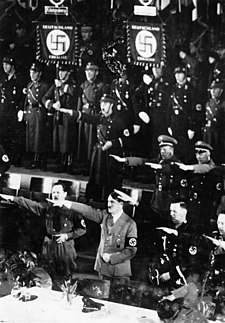

Erich Koch headed the East Prussian Nazi party from 1928. He led the district from 1932. This period was characterized by efforts to collectivize the local agriculture and ruthlessness in dealing with his critics inside and outside the Party.[21] He also had long-term plans for mass-scale industrialization of the largely agricultural province. These actions made him unpopular among the local peasants.[21] In 1932 the local paramilitary SA had already started to terrorise their political opponents. On the night of 31 July 1932 there was a bomb attack on the headquarters of the Social Democrats in Königsberg, the Otto-Braun-House. The Communist politician Gustav Sauf was killed; the executive editor of the Social Democratic newspaper "Königsberger Volkszeitung", Otto Wyrgatsch; and the German People's Party politician Max von Bahrfeldt were all severely injured. Members of the Reichsbanner were assaulted while the local Reichsbanner Chairman of Lötzen, Kurt Kotzan, was murdered on 6 August 1932.[22][23]
Through publicly funded emergency relief programs concentrating on agricultural land-improvement projects and road construction, the "Erich Koch Plan" for East Prussia allegedly made the province free of unemployment: on 16 August 1933 Koch reported to Hitler that unemployment had been banished entirely from the province, a feat that gained admiration throughout the Reich.[24] Koch's industrialization plans provoked conflict with R. Walther Darré, who held the office of the Reich Peasant Leader (Reichsbauernführer) and Minister of Agriculture. Darré, a neopaganist rural romantic, wanted to enforce his vision of an agricultural East Prussia. When his "Land" representatives challenged Koch's plans, Koch arrested them.[25]
After the Nazis took power in Germany, opposition politicians were persecuted and newspapers banned. The Otto-Braun-House was requisitioned to become the headquarters of the SA, which used the house to imprison and torture its opponents. Walter Schütz, a communist member of the Reichstag, was murdered here.[26] In 1938 the Nazis altered about one-third of the toponyms of the area, eliminating, Germanizing, or simplifying a number of Old Prussian, as well as those Polish or Lithuanian names originating from colonists and refugees to Prussia during and after the Protestant Reformation. More than 1,500 places were ordered to be renamed by 16 July 1938 following a decree issued by Gauleiter and Oberpräsident Erich Koch and initiated by Adolf Hitler.[27] Many who would not cooperate with the rulers of Nazi Germany were sent to concentration camps and held prisoner there until their death or liberation.
World War II
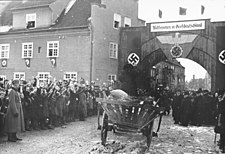
After the 1939 invasion of Poland by Nazi Germany opening World War II, the borders of East Prussia were revised. Regierungsbezirk Westpreußen became part of Reichsgau Danzig-West Prussia, while Regierungsbezirk Zichenau was added to East Prussia. Originally part of the Zichenau region, the Sudauen district in Sudovia was later transferred to the Gumbinnen region. In 1939 East Prussia had 2.49 million inhabitants, 85% of them ethnic Germans, the others Poles in the south who, according to Polish estimates numbered in the interwar period around 300,000-350,000,[28] the Latvian speaking Kursenieki, and Lietuvininkai who spoke Lithuanian in the northeast. Most German East Prussians, Masurians, Kursieniki, and Lietuvininkai were Lutheran, while the population of Ermland was mainly Roman Catholic due to the history of its bishopric. The East Prussian Jewish Congregation declined from about 9,000 in 1933 to 3,000 in 1939, as most fled from Nazi rule.[29] Those who remained were later deported and killed in the Holocaust.
In 1939 the Regierungsbezirk Zichenau was annexed by Germany and incorporated into East Prussia. Parts of it were transferred to other regions, e.g. Suwałki to Regierungsbezirk Gumbinnen and Soldau to Regierungsbezirk Allenstein. Despite Nazi propaganda presenting all of the regions annexed as possessing significant German populations that wanted reunification with Germany, the Reich's statistics of late 1939 show that only 31,000 out of 994,092 people in this territory were ethnic Germans.
East Prussia was only slightly affected by the war until January 1945, when it was devastated during the East Prussian Offensive. Most of its inhabitants became refugees in bitterly cold weather during the Evacuation of East Prussia.
Evacuation of East Prussia
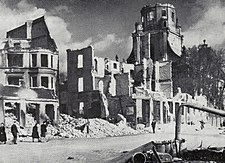
In 1944 the medieval city of Königsberg, which had never been severely damaged by warfare in its 700 years of existence, was almost completely destroyed by two RAF Bomber Command raids – the first on the night of 26/27 August 1944, with the second one three nights later, overnight on 29/30 August 1944. Winston Churchill (The Second World War, Book XII) had erroneously believed it to be "a modernized heavily defended fortress" and ordered its destruction.
Gauleiter Erich Koch delayed the evacuation of the German civilian population until the Eastern Front approached the East Prussian border in 1944. The population had been systematically misinformed by Endsieg Nazi propaganda about the real state of military affairs. As a result, many civilians fleeing westward were overtaken by retreating Wehrmacht units and the rapidly advancing Red Army.
Reports of Soviet atrocities in the Nemmersdorf massacre of October 1944 and organized rape spread fear and desperation among the civilians. Thousands lost their lives during the sinkings (by Soviet submarine) of the evacuation ships Wilhelm Gustloff, the Goya, and the General von Steuben. Königsberg surrendered on 9 April 1945, following the desperate four-day Battle of Königsberg. The number of civilians killed is estimated to be at least 300,000.
However, most of the German inhabitants, which then consisted primarily of women, children and old men, did manage to escape the Red Army as part of the largest exodus of people in human history: "A population which had stood at 2.2 million in 1940 was reduced to 193,000 at the end of May 1945."[30][31]
History after partition and annexation
Following Nazi Germany's defeat in World War II in 1945, East Prussia was partitioned between Poland and the Soviet Union according to the Potsdam Conference, pending a final peace conference with Germany. Since a peace conference never took place, the region was effectively ceded by Germany.[32] Southern East Prussia was placed under Polish administration, while northern East Prussia was divided between the Soviet republics of Russia (the Kaliningrad Oblast) and Lithuania (the constituent counties of the Klaipėda Region). The city of Königsberg was renamed Kaliningrad in 1946. Most of the German population of the province had left during the evacuation at the end of the war, but several hundreds of thousands died during the years 1944–46 and the remainder were subsequently expelled.
Expulsion of Germans from East Prussia after World War II
Shortly after the end of the war in May 1945, Germans who had fled in early 1945 tried to return to their homes in East Prussia. An estimated number of 800,000 Germans were living in East Prussia during the summer of 1945.[33] Many more were prevented from returning, and the German population of East Prussia was almost completely expelled by the communist regimes. During the war and for some time thereafter 45 camps were established for about 200,000-250,000 forced labourers, the vast majority of whom were deported to the Soviet Union, including the Gulag camp system.[34] The largest camp with about 48,000 inmates was established at Deutsch Eylau (Iława).[34] Orphaned children who were left behind in the zone occupied by the Soviet Union were referred to as Wolf children.
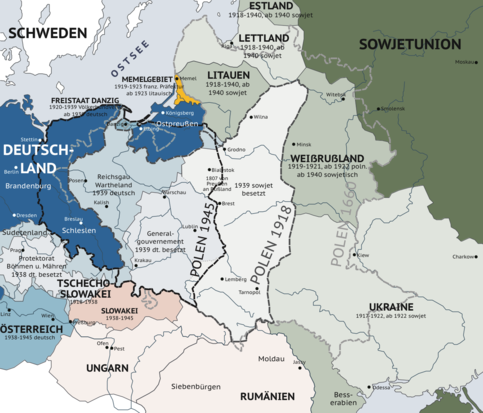 An illustration of the changing borders in Eastern Europe before, during, and after World War II (Map is written in German)
An illustration of the changing borders in Eastern Europe before, during, and after World War II (Map is written in German)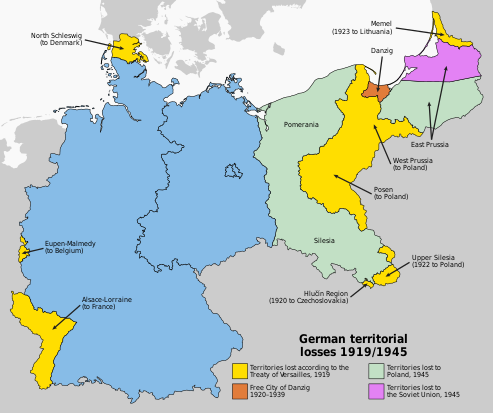 Changes in Germany's borders as a result of both World Wars, with the partition of East Prussia.
Changes in Germany's borders as a result of both World Wars, with the partition of East Prussia.
Southern East Prussia to Poland
Representatives of the Polish government officially took over the civilian administration of the southern part of East Prussia on 23 May 1945.[34] Subsequently, Polish expatriates from Polish lands annexed by the Soviet Union as well as Ukrainians and Lemkos from southern Poland, expelled in Operation Vistula in 1947, were settled in the area, now called Warmian-Masurian Voivodeship. In 1950 the Olsztyn Voivodeship counted 689,000 inhabitants, 22.6% of them coming from areas annexed by the Soviet Union, 10% Ukrainians, and 18.5% of them pre-war inhabitants. The remaining pre-war population was treated as Germanized Poles and a policy of re-Polonization was pursued throughout the country[35] Most of these "Autochthons" chose to emigrate to West Germany from the 1950s through 1980s (between 1970 and 1988 55,227 persons from Warmia and Masuria moved to Western Germany).[36] Local toponyms were Polonised by the Polish Commission for the Determination of Place Names.[37]
Origin of the post-war population
During the Polish post-war census of December 1950, data about the pre-war places of residence of the inhabitants as of August 1939 was collected. In case of children born between September 1939 and December 1950, their origin was reported based on the pre-war places of residence of their mothers. Thanks to this data it is possible to reconstruct the pre-war geographical origin of the post-war population. The same area corresponding to pre-war southern parts of East Prussia (which became Polish in 1945) was inhabited in December 1950 by (this data includes the whole of Olsztyn Voivodeship as well as some counties of pre-1939 East Prussia which were incorporated to Białystok Voivodeship and to Gdańsk Voivodeship after World War II):
| Region (within 1939 borders): | Number | Percent |
|---|---|---|
| Autochthons (1939 DE/FCD citizens) | 134,702 | 15,90% |
| Polish expellees from Kresy (USSR) | 172,480 | 20,36% |
| Poles from abroad except the USSR | 5,734 | 0,68% |
| Resettlers from the City of Warsaw | 22,418 | 2,65% |
| From Warsaw region (Masovia) | 158,953 | 18,76% |
| From Białystok region and Sudovia | 102,634 | 12,11% |
| From pre-war Polish Pomerania | 83,921 | 9,90% |
| Resettlers from Poznań region | 7,371 | 0,87% |
| Katowice region (East Upper Silesia) | 2,536 | 0,30% |
| Resettlers from the City of Łódź | 1,666 | 0,20% |
| Resettlers from Łódź region | 6,919 | 0,82% |
| Resettlers from Kielce region | 20,878 | 2,46% |
| Resettlers from Lublin region | 60,313 | 7,12% |
| Resettlers from Kraków region | 5,515 | 0,65% |
| Resettlers from Rzeszów region | 47,626 | 5,62% |
| place of residence in 1939 unknown | 13,629 | 1,61% |
| Total pop. in December 1950 | 847,295 | 100,00% |
Over 80% of the 1950 inhabitants were new in the region, less than 20% had resided in the province already back in 1939 (so called autochthons, who had German citizenship before World War II and were granted Polish citizenship after 1945). Over 20% of all inhabitants were Poles expelled from areas of Eastern Poland annexed by the USSR. The rest were mostly people from neighbouring areas located right next to East Prussia (almost 44% came from Masovia, Sudovia, Podlachia and pre-war Polish Pomerania) and southern Poland (~16%).
Northern part to the Soviet Union

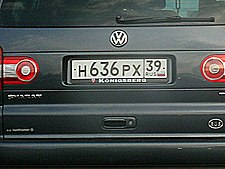
In April 1946, northern East Prussia became an official province of the Russian SFSR as the "Kyonigsbergskaya Oblast", with the Memel Territory becoming part of the Lithuanian SSR. In June 1946 114,070 German and 41,029 Soviet citizens were registered in the Oblast, with an unknown number of disregarded unregistered persons. In July of that year, the historic city of Königsberg was renamed Kaliningrad to honour Mikhail Kalinin and the area named the Kaliningrad Oblast. Between 24 August and 26 October 1948 21 transports with in total 42,094 Germans left the Oblast to the Soviet Occupation Zone (which became East Germany). The last remaining Germans left in November 1949 (1,401 persons) and January 1950 (7 persons).[38]
The Prussian Lithuanians also experienced the same fate.
A similar fate befell the Curonians who lived in the area around the Curonian Lagoon. While many fled from the Red Army during the evacuation of East Prussia, Curonians that remained behind were subsequently expelled by the Soviet Union. Only 219 lived along the Curonian Spit in 1955. Many had German names such as Fritz or Hans, a cause for anti-German discrimination. The Soviet authorities considered the Curonians fascists. Because of this discrimination, many immigrated to West Germany in 1958, where the majority of Curonians now live.
After the expulsion of the German population ethnic Russians, Belarusians, and Ukrainians were settled in the northern part. In the Soviet part of the region, a policy of eliminating all remnants of German history was pursued. All German place names were replaced by new Russian names. The exclave was a military zone, which was closed to foreigners; Soviet citizens could only enter with special permission. In 1967 the remnants of Königsberg Castle were demolished on the orders of Leonid Brezhnev to make way for a new "House of the Soviets".
Modern status
Since the fall of Communism in 1991, some German groups have tried to help settle the Volga Germans from eastern parts of European Russia in the Kaliningrad Oblast. This effort was only a small success, however, as most impoverished Volga Germans preferred to emigrate to the richer Federal Republic of Germany, where they could become German citizens through the right of return.
Although the 1945–1949 expulsion of Germans from the northern part of former East Prussia was often conducted in a violent and aggressive way by Soviet officials, the present Russian inhabitants of the Kaliningrad Oblast have much less animosity towards Germans. German names have been revived in commercial Russian trade and there is sometimes talk of reverting Kaliningrad's name to its historic name of Königsberg. The city centre of Kaliningrad was completely rebuilt, as British bombs in 1944 and the Soviet siege in 1945 had left it in nothing but ruins.
The borders of the present-day Warmian-Masurian Voivodeship in Poland correspond closely to those of southern East Prussia.
Administration
The Prussian central government appointed for every province an Oberpräsident ("Upper President") carrying out central prerogatives on the provincial level and supervising the implementation of central policy on the lower levels of administration.
Since 1875, with the strengthening of self-rule, the urban and rural districts (Kreise) within each province (sometimes within each governorate) formed a corporation with common tasks and assets (schools, traffic installations, hospitals, cultural institutions, jails etc.) called the Provinzialverband (provincial association). Initially the assemblies of the urban and rural districts elected representatives for the provincial diets (Provinziallandtage), which were thus indirectly elected. As of 1919 the provincial diets (or as to governorate diets, the so-called Kommunallandtage) were directly elected by the citizens of the provinces (or governorates, respectively). These parliaments legislated within the competences transferred to the provincial associations. The provincial diet of East Prussia elected a provincial executive body (government), the provincial committee (Provinzialausschuss), and a head of province, the Landeshauptmann ("Land Captain"; till the 1880s titled Landdirektor, land director).[39]
Upper Presidents of East Prussia and Prussia
- 1765–1791: Johann Friedrich von Domhardt, president of the Gumbinnen and Königsberg War and Demesnes Chambers
- 1791–1808: Friedrich Leopold von Schrötter, president of the Gumbinnen and Königsberg War and Demesnes Chambers, as of 1795 Minister for East and New East Prussia
- 1808–1814: vacancy?
- 1814–1824: Hans Jakob von Auerswald, upper president of East Prussia
- 1824–1842: Heinrich Theodor von Schön, upper president of Prussia, merged from East and West Prussia, since 1816 already upper president of West Prussia
- 1842–1848: Carl Wilhelm von Bötticher, upper president of Prussia
- 1848–1849: Rudolf von Auerswald, upper president of Prussia
- 1849–1850: Eduard Heinrich von Flottwell (1786–1865), upper president of Prussia
- 1850–1868: Franz August Eichmann, upper president of Prussia
- 1868–1869: vacancy
- 1869–1882: Carl Wilhelm Heinrich Georg von Horn, upper president of Prussia, after 1878 of East Prussia
- 1882–1891: Albrecht Heinrich von Schlieckmann, upper president of East Prussia
- 1891–1895: Count Udo zu Stolberg-Wernigerode, upper president of East Prussia
- 1895–1901: Count Wilhelm von Bismarck-Schönhausen, upper president of East Prussia
- 1901–1903: Hugo Samuel von Richthofen, upper president of East Prussia
- 1903–1907: Count Friedrich von Moltke, upper president of East Prussia
- 1907–1914: Ludwig von Windheim, upper president of East Prussia
- 1914–1916: Adolf Tortilowicz von Batocki-Friebe, upper president of East Prussia
- 1916–1918: Friedrich von Berg, upper president of East Prussia
- 1918–1919: Adolf Tortilowicz von Batocki-Friebe, upper president of East Prussia
- 1919–1920: August Winnig (SPD), upper president of East Prussia
- 1920–1932: Ernst Siehr (DDP), upper president of East Prussia
- 1932–1933: Wilhelm Kutscher (DNVP), upper president of East Prussia
- 1933–1945: Erich Koch (NSDAP), upper president of East Prussia
Elections to the provincial diets
Summary of the East Prussian Provincial Diet direct election results
| Parties | % 1921 |
+/- 1921 |
Seats 1921 |
+/- 1921 |
% 1925 |
+/- 1925 |
Seats 1925 |
+/- 1925 |
% 1929 |
+/- 1929 |
Seats 1929 |
+/- 1929 |
% 1933 |
+/- 1933 |
Seats 1933 |
+/- 1933 | |
|---|---|---|---|---|---|---|---|---|---|---|---|---|---|---|---|---|---|
| SPD | 24.1 | 20 | 24.8 | +0.7 (-) | 22 | +2 (-4) | 26 | +1.2 | 23 | +1 | 13.6 | -12.4 | 12 | -11 | |||
| USPD | 6 | +6 | merged in SPD | ||||||||||||||
| DNVP[40] | 13.4 | +13.4 | 11 | +11 | 45.6[41] | 40 | (+4) | 31.2 | (+17.8) | 27 | (+16) | 12.7[40] | -18.5 | 11 | -16 | ||
| DVP | 3.6 | +3.6 | 4 | +4 | 8.7 | (+5.1) | 8 | (+4) | 0 | -8 | |||||||
| BWA | 16 | +16 | 0 | -16 | 0 | 0 | 0 | 0 | |||||||||
| Zentrum | 9.3 | 8 | +8 | 6.9 | -2.4 | 6 | -2 | 8.1 | +1.2 | 7 | +1 | 7 | -1.1 | 7 | 0 | ||
| KPD[42] | 7 | +7 | 6 | +6 | 6.9 | -0.1 | 6 | 0 | 8.6 | +1.7 | 8 | +2 | 6 | -2.6 | 6 | -2 | |
| BWW | 6 | +6 | 0 | -6 | 0 | 0 | 0 | 0 | |||||||||
| Parties | % 1921 |
+/- 1921 |
Seats 1921 |
+/- 1921 |
% 1925 |
+/- 1925 |
Seats 1925 |
+/- 1925 |
% 1929 |
+/- 1929 |
Seats 1929 |
+/- 1929 |
% 1933 |
+/- 1933 |
Seats 1933 |
+/- 1933 | |
| DDP | 5.7 | +5.7 | 6 | +6 | 3.6 | -2.1 | 3 | -3 | 2.8 | -0.8 | 3 | 0 | 0 | -3 | |||
| NSDAP | not run | not run | not run | not run | 4.3 | 4 | +4 | 58.2 | +53,9 | 51 | +47 | ||||||
| LL/WP[43] | 2 | +2 | 4.2 | +4.2 | 4 | +2 | 4 | -1.2 | 4 | 0 | 0 | -4 | |||||
| DFP | not run | not run | not run | not run | 4.2 | +4.2 | 4 | +4 | 0 | -4 | 0 | 0 | |||||
| CSVD | not run | not run | not run | not run | not run | not run | not run | not run | 3 | +3 | 3 | +3 | 0 | -3 | |||
| AuA | not run | not run | not run | not run | 2 | +2 | 0 | -2 | 0 | 0 | |||||||
| FOW | 2 | +2 | 0 | -2 | 0 | 0 | 0 | 0 | |||||||||
| Poles' Party | 1 | +1 | 0 | -1 | 0 | 0 | 0 | 0 | |||||||||
| Others | 2 | +? | 0 | -2 | 0 | 0 | 0 | 0 | |||||||||
| Total 1921 |
85 | Total 1925 |
87 | Total 1929 |
87 | Total 1933 |
87 | ||||||||||
Land Directors and Land Captains of East Prussia
- 1876–1878: Heinrich Edwin Rickert (NLP, later DFP), titled land director
- 1878–1884: Kurt von Saucken-Tarputschen (Fortschritt, later DFP), titled land director
- 1884–1888: Alfred von Gramatzki (DKP), titled land director
- 1888–1896: Klemens von Stockhausen, titled land director
- 1896–1909: Rudolf von Brandt, titled land captain
- 1909–1916: Friedrich von Berg, titled land captain
- 1916–1928: Manfred Graf von Brünneck-Bellschwitz, titled land captain
- 1928–1936: Paul Blunk, titled land captain
- 1936–1941: Helmuth von Wedelstädt (NSDAP), titled land captain
- 1941–1945: vacancy
- 1941–1945: Reinhard Bezzenberger, first land councillor, per pro
Cities and towns
| City/Town | District (Kreis) | Pop. in 1939 | Current Name | Current Administrative Unit |
|---|---|---|---|---|
| Allenburg | Landkreis Wehlau | 2 694 | Druzhba | Kaliningrad Oblast (Russia) |
| Allenstein | Landkreis Allenstein | 50 396 | Olsztyn | Warmian-Masurian Voivodeship (Poland) |
| Angerburg | Landkreis Angerburg | 10 922 | Węgorzewo (Węgobork) | Warmia-Masuria |
| Arys | Landkreis Johannisburg | 3 553 | Orzysz | Warmia-Masuria |
| Barten | Landkreis-Rastenburg | 1 541 | Barciany | Warmia-Masuria |
| Bartenstein | Landkreis Bartenstein | 12 912 | Bartoszyce | Warmia-Masuria |
| Bischofsburg | Landkreis Rößel | Biskupiec | Warmia-Masuria | |
| Bischofstein (Ostpreußen) | Rößel | 3 200 | Bisztynek | Warmia-Masuria |
| Braunsberg | Landkreis Braunsberg | 21 142 | Braniewo | Warmia-Masuria |
| Darkehmen/Angerapp | Landkreis Darkehmen | Ozyorsk | Kaliningrad | |
| Domnau | Bartenstein | Domnovo | Kaliningrad | |
| Elbing | Stadtkreis | 85 952 | Elbląg | Warmia-Masuria |
| Eydtkuhnen | Landkreis Stallupönen | 4 922 | Chernyshevskoye | Kaliningrad |
| Fischhausen | Landkreis Samland | 3 879 | Primorsk | Kaliningrad |
| Frauenburg (Ostpreußen) | Braunsberg | 2 951 | Frombork | Warmia-Masuria |
| Friedland (Ostpreußen) | Bartenstein | Pravdinsk | Kaliningrad | |
| Gehlenburg | Johannisburg | Biała Piska | Warmia-Masuria | |
| Gerdauen | Landkreis Gerdauen | 5 118 | Zheleznodorozhny | Kaliningrad |
| Gilgenburg | Landkreis Osterode | 1 700 | Dąbrówno | Warmia-Masuria |
| Goldap | Landkreis Goldap | 12 786 | Gołdap | Warmia-Masuria |
| Gumbinnen | Landkreis Gumbinnen | 24 534 | Gusev | Kaliningrad |
| Guttstadt | Landkreis Heilsberg | Dobre Miasto | Warmia-Masuria | |
| Heiligenbeil | Landkreis Heiligenbeil | 12 100 | Mamonovo | Kaliningrad |
| Heilsberg | Heilsberg | Lidzbark Warmiński | Warmia-Masuria | |
| Heydekrug | Landkreis Heydekrug | 4 836 | Šilutė | Klaipėda County (Lithuania) |
| Hohenstein | Osterode | Olsztynek | Warmia-Masuria | |
| Insterburg | Landkreis Insterburg | 48 711 | Chernyakhovsk | Kaliningrad |
| Johannisburg | Johannisburg | Pisz (Jańsbork) | Warmia-Masuria | |
| Königsberg (Preußen) | Stadtkreis | 372 000 | Kaliningrad | Kaliningrad |
| Kreuzburg (Ostpreußen) | Landkreis Preußisch Eylau | Slavskoye | Kaliningrad | |
| Labiau | Landkreis Labiau | 6 527 | Polessk | Kaliningrad |
| Landsberg in Ostpreußen | Preußisch Eylau | Górowo Iławeckie | Warmia-Masuria | |
| Liebemühl | Osterode | Miłomłyn | Warmia-Masuria | |
| Liebstadt | Landkreis Mohrungen | 2 742 | Miłakowo | Warmia-Masuria |
| Lötzen | Landkreis Lötzen | 13 000 | Giżycko (Lec) | Warmia-Masuria |
| Lyck | Landkreis Lyck | 16 482 | Ełk (Łęg) | Warmia-Masuria |
| Marggrabowa/Treuburg | Landkreis Oletzko/Treuburg | Olecko | Warmia-Masuria | |
| Marienburg in Westpreußen | Landkreis Marienburg (Westpr.) | Malbork | Pomeranian Voivodeship (Poland) | |
| Mehlsack | Braunsberg | Pieniężno (Melzak) | Warmia-Masuria | |
| Memel | Stadtkreis | 41 297 | Klaipėda | Klaipėda |
| Mohrungen | Mohrungen | 5 500 | Morąg | Warmia-Masuria |
| Mühlhausen | Landkreis Preußisch Holland | Młynary | Warmia-Masuria | |
| Neidenburg | Landkreis Neidenburg | 9 201 | Nidzica (Nibork) | Warmia-Masuria |
| Nikolaiken | Landkreis Sensburg | Mikołajki | Warmia-Masuria | |
| Nordenburg | Gerdauen | 3 173 | Krylovo | Kaliningrad |
| Ortelsburg | Landkreis Ortelsburg | 14 234 | Szczytno | Warmia-Masuria |
| Osterode (Ostpreußen) | Osterode | 19 519 | Ostróda | Warmia-Masuria |
| Passenheim | Ortelsburg | 2 431 | Pasym | Warmia-Masuria |
| Peterswalde | Osterode | Piertzwald | Warmia-Masuria | |
| Pillau | Samland | 12 000 | Baltiysk | Kaliningrad |
| Preußisch Eylau | Preußisch Eylau | 7 485 | Bagrationovsk | Kaliningrad |
| Preußisch Holland | Preußisch Holland | Pasłęk | Warmia-Masuria | |
| Ragnit | Landkreis Tilsit-Ragnit | 10 094 | Neman | Kaliningrad |
| Rastenburg | Rastenburg | 19 634 | Kętrzyn (Rastembork) | Warmia-Masuria |
| Rhein (Ostpreußen) | Lötzen | Ryn | Warmia-Masuria | |
| Rößel | Rößel | 5 000 | Reszel | Warmia-Masuria |
| Saalfeld | Mohrungen | Zalewo | Warmia-Masuria | |
| Schippenbeil | Bartenstein | Sępopol | Warmia-Masuria | |
| Schirwindt | Landkreis Pillkallen | Kutuzovo | Kaliningrad | |
| Pillkallen-Schlossberg | Pillkallen | Dobrovolsk | Kaliningrad | |
| Seeburg | Rößel | Jeziorany (Zybork) | Warmia-Masuria | |
| Sensburg | Sensburg | Mrągowo (Żądzbork) | Warmia-Masuria | |
| Soldau | Neidenburg | 5 349 | Działdowo | Warmia-Masuria |
| Stallupönen | Stallupönen | 6 608 | Nesterov | Kaliningrad |
| Tapiau | Wehlau | 9 272 | Gvardeysk | Kaliningrad |
| Tilsit | Stadtkreis | 59 105 | Sovetsk | Kaliningrad |
| Wartenburg (Ostpreußen) | Allenstein | 5 841 | Barczewo (Wartembork) | Warmia-Masuria |
| Wehlau | Wehlau | 7 348 | Znamensk | Kaliningrad |
| Willenberg | Ortelsburg | 2 600 | Wielbark | Warmia-Masuria |
| Wormditt | Braunsberg | Orneta | Warmia-Masuria | |
| Zinten | Heiligenbeil | Kornevo | Kaliningrad |
See also
- Drang nach Osten
- East Colonisation
- Landsmannschaft Ostpreußen
- East Prussian Regional Museum
References
- The Columbia Encyclopedia, Sixth Edition (2008), East Prussia
- Schaitberger, L. "Ostpreußen: The Great Trek". Retrieved 8 December 2016.
- Encyclopædia Britannica: Old-Prussian-language; Gordon, Raymond G., Jr. (ed.): Ethnologue: Languages of the World, 2005, Prussian
- tenn@owlnet.rice.edu. "Sarmatian Review XV.1: Davies". Retrieved 8 December 2016.
- A Treatise on Political Economy
- "LINGUISTIC PRINCIPLES OF THE RECOVERY OF OLD PRUSSIAN". Retrieved 8 December 2016.
- Plater, Stanisław (1825). Jeografia wschodniéy części Europy czyli Opis krajów przez wielorakie narody słowiańskie zamieszkanych: obejmujący Prussy, Xsięztwo Poznańskie, Szląsk Pruski, Gallicyą, Rzeczpospolitę Krakowską, Krolestwo Polskie i Litwę (in Polish). Wrocław: u Wilhelma Bogumiła Korna. p. 17.
- Andree, Karl (1831). Polen: in geographischer, geschichtlicher und culturhistorischer Hinsicht (in German). Verlag von Ludwig Schumann. p. 218.
- Hassel, Georg (1823). Statistischer Umriß der sämmtlichen europäischen und der vornehmsten außereuropäischen Staaten, in Hinsicht ihrer Entwickelung, Größe, Volksmenge, Finanz- und Militärverfassung, tabellarisch dargestellt; Erster Heft: Welcher die beiden großen Mächte Österreich und Preußen und den Deutschen Staatenbund darstellt (in German). Verlag des Geographischen Instituts Weimar. p. 41.
- Haxthausen, August (1839). Die Ländliche Verfassung in den Einzelnen Provinzen der Preussischen Monarchie (in German). pp. 75–91.
- "Monastery of the Dormition of the Mother of God in Wojnowo (Eckersdorf)". wojnowo.net.
- Tetzner, Franz (1902). Die Slawen in Deutschland: beiträge zur volkskunde der Preussen, Litauer und Letten, der Masuren und Philipponen, der Tschechen, Mährer und Sorben, Polaben und Slowinzen, Kaschuben und Polen. Braunschweig: Verlag von F. Vieweg. pp. 212–248.
- "Old Believers in Poland - historical and cultural information". Poland's Linguistic Heritage. Archived from the original on 23 December 2018. Retrieved 23 December 2018.
- Hoffmann, Johann Gottfried (1818). Übersicht der Bodenfläche und Bevölkerung des Preußischen Staates : aus den für das Jahr 1817 mtlich eingezogenen Nachrichten. Berlin: Decker. p. 51.
- Ethnic Groups and Population Changes in Twentieth-Century Central-Eastern Europe: History, Data, and Analysis. Piotr Eberhardt,page 166, 2003 M E Sharpe Inc
- "Gemeindeverzeichnis Deutschland".
- "Rocznik statystyki Rzeczypospolitej Polskiej 1920/21". Rocznik statystyki Rzeczypospolitej Polskiej (in Polish and French). Warsaw: Główny Urząd Statystyczny. I: 56–62. 1921.
- Jehke, Rolf. "Rbz. Allenstein: 10.1.1920 Abtretung des Kreises Neidenburg (teilweise) an Polen; 15.8.1920 Abtretung der Landgemeinden Groschken, Groß Lehwalde (teilweise), Klein Lobenstein (teilweise), Gut Nappern und der Gutsbezirke Groß Grieben (teilweise) und Klein Nappern (teilweise) an Polen". territorial.de.
- "Działdowo, Soldauer Gebiet, Soldauer Ländchen". GOV The Historic Gazetteer.
- Khan, Daniel-Erasmus (2004). Die deutschen Staatsgrenzen. Tübingen: Mohr Siebeck. p. 78. ISBN 3-16-148403-7.
- Robert S. Wistrich, Who's who in Nazi Germany, 2002, pp. 142-143.
- Matull, Wilhelm (1973). "Ostdeutschlands Arbeiterbewegung: Abriß ihrer Geschichte, Leistung und Opfer" (PDF) (in German). Holzner Verlag. p. 350.
- Die aufrechten Roten von Königsberg Spiegel.de, 28 June 2009 (in German)
- Dan P. Silverman (1993). "Fantasy and Reality in Nazi Work-Creation Programs, 1933-1936". The Journal of Modern History. 65 (1): 113–151. doi:10.1086/244609.
- Richard Steigmann-Gall, The Holy Reich - Nazi Conceptions of Christianity 1919-1945, 2004, p. 102.
- Matull, page 357
- Neumärker, Uwe; et al. (2007). "Wolfsschanze": Hitlers Machtzentrale im Zweiten Weltkrieg (in German) (3 ed.). Ch. Links Verlag. ISBN 3-86153-433-9.
- Szkolnictwo polskie w Niemczech 1919-1939, Henryk Chałupczak Wydawnictwo Uniwersytetu Marii Curie-Skłodowskiej,page9 1996
- Rademacher, Michael. "Deutsche Verwaltungsgeschichte Preußen, Provinz Ostpreußen 1871 - 1945". Retrieved 8 December 2016.
- Beevor, Antony, Berlin: The Downfall 1945, Penguin Books (2002). ISBN 0-670-88695-5
- Beevor, Antony, Berlin: The Downfall 1945, chapters 1-8, Penguin Books (2002). ISBN 0-670-88695-5
- Geoffrey K. Roberts, Patricia Hogwood (2013). The Politics Today Companion to West European Politics. Oxford University Press. p. 50.; Piotr Stefan Wandycz (1980). The United States and Poland. Harvard University Press. p. 303.; Phillip A. Bühler (1990). The Oder-Neisse Line: a reappraisal under international law. East European Monographs. p. 33.
- Andreas Kossert, Damals in Ostpreussen, p. 168, München 2008 ISBN 978-3-421-04366-5
- Ther, Philipp; Siljak, Anna (2001). Redrawing nations: ethnic cleansing in East-Central Europe, 1944-1948. Rowman&Littlefield Publishers. p. 109. ISBN 0-7425-1094-8.
- Ethnic Germans in Poland and the Czech Republic:A Comparative Evaluation by Karl Cordell and Stefan Wolff
- Andreas Kossert, Ostpreussen - Geschichte und Mythos, p.352, ISBN 3-88680-808-4
- The Polish toponymic guidelines (p.9)
- Andreas Kossert, Damals in Ostpreussen, pp. 179–183, München 2008 ISBN 978-3-421-04366-5
- In some Prussian provinces the same office continued to be called Landesdirektor also thereafter. Cf. article: "Landesdirektor", in: Der Große Brockhaus: Handbuch des Wissens in zwanzig Bänden: 21 vols.; Leipzig: Brockhaus, 151928–1935; vol. 11 (1932), p. 71.
- In 1933 the DNVP ran under the list KFSWR, also including Der Stahlhelm and the LB.
- DVP and DNVP formed the united list called Prussian Block (PB, Preußenblock).
- In 1921 the party was named United Communist Party of Germany, VKPD.
- In 1921 the Landliste (LL, Rural List) gained two seats, in 1926 the LL formed a united list with the WP and the East Prussian Farmers' Federation (OBB), in 1929 they all ran as part of the WP.
Notes
- Part of pre-1918 county Nidzica with Działdowo and with around 27 thousand inhabitants;[17] as well as parts of county Ostróda near Dąbrówno, with areas around Groszki, Lubstynek, Napromek, Czerlin, Lewałd Wielki, Grzybiny and with around 4786 inhabitants.[20] Too small to form its own voivodeship, this territory was incorporated to intewar Pomeranian Voivodeship.
Bibliography
- Publications in English
- Baedeker, Karl, Northern Germany, 14th revised edition, London, 1904.
- Beevor, Antony (2002). "chapters 1-8". Berlin: The Downfall 1945. Penguin Books. ISBN 0-670-88695-5. Archived from the original on 5 February 2006. Retrieved 6 May 2006. (on the years 1944/45)
- Alfred-Maurice de Zayas, " Nemesis at Potsdam". London, 1977. ISBN 0-8032-4910-1.
- Alfred-Maurice de Zayas, A Terrible Revenge: The Ethnic Cleansing of the East European Germans, 1944-1950, 1994, ISBN 0-312-12159-8
- Carsten, F. L. "East Prussia" History 33#119 (1948), pp. 241–246 online historiography of medieval and early modern period.
- Dickie, Reverend J.F., with E.Compton, Germany, A & C Black, London, 1912.
- Douglas, R.M.: Orderly and Humane. The Expulsion of the Germans after the Second World War. Yale University Press, 2012. ISBN 978-0300166606.
- von Treitschke, Heinrich, History of Germany - vol.1: The Wars of Emancipation, (translated by E & C Paul), Allen & Unwin, London, 1915.
- Powell, E. Alexander, Embattled Borders, London, 1928.
- Prausser, Steffen and Rees, Arfon: The Expulsion of the "German" Communities from Eastern Europe at the End of the Second World War. Florence, Italy, European University Institute, 2004.
- Naimark, Norman: Fires of Hatred. Ethnic Cleansing in Twentieth-Century Europe. Cambridge, Harvard University Press, 2001.
- Steed, Henry Wickham, Vital Peace - A Study of Risks, Constable & Co., London, 1936.
- Newman, Bernard, Danger Spots of Europe, London, 1938.
- Wieck, Michael: A Childhood Under Hitler and Stalin: Memoirs of a "Certified Jew," University of Wisconsin Press, 2003, ISBN 0-299-18544-3.
- Woodward, E.L., Butler, Rohan; Medlicott, W.N., Dakin, Douglas, & Lambert, M.E., et al. (editors), Documents on British Foreign Policy 1919-1939, Three Series, Her Majesty's Stationery Office (HMSO), London, numerous volumes published over 25 years. Cover the Versailles Treaty including all secret meetings; plebiscites and all other problems in Europe; includes all diplomatic correspondence from all states.
- Previté-Orton, C.W., Professor, The Shorter Cambridge Medieval History, Cambridge University Press, 1952 (2 volumes).
- Balfour, Michael, and John Mair, Four-Power Control in Germany and Austria 1945-1946, Oxford University Press, 1956.
- Kopelev, Lev, To Be Preserved Forever, ("Хранить вечно"), 1976.
- Koch, H.W., Professor, A History of Prussia, Longman, London, 1978/1984, (P/B), ISBN 0-582-48190-2
- Koch, H.W., Professor, A Constitutional History of Germany in the 19th and 20th Centuries, Longman, London, 1984, (P/B), ISBN 0-582-49182-7
- MacDonogh, Giles, Prussia, Sinclair-Stevenson, London, 1994, ISBN 1-85619-267-9
- Nitsch, Gunter, Weeds Like Us, AuthorHouse, 2006, ISBN 978-1-4259-6755-0
- Publications in German
- B. Schumacher: Geschichte Ost- und Westpreussens, Würzburg 1959
- Boockmann, Hartmut: Ostpreußen und Westpreußen (= Deutsche Geschichte im Osten Europas). Siedler, Berlin 1992, ISBN 3-88680-212-4
- Buxa, Werner and Hans-Ulrich Stamm: Bilder aus Ostpreußen
- Dönhoff, Marion Gräfin v. :Namen die keiner mehr nennt - Ostpreußen, Menschen und Geschichte
- Dönhoff, Marion Gräfin v.: Kindheit in Ostpreussen
- Falk, Lucy: Ich Blieb in Königsberg. Tagebuchblätter aus dunklen Nachkriegsjahren
- Kibelka, Ruth: Ostpreußens Schicksaljahre, 1945-1948
- Bernd, Martin (1998). Masuren, Mythos und Geschichte. Karlsruhe: Evangelische Akademie Baden. ISBN 83-85135-93-6.
- Nitsch, Gunter: "Eine lange Flucht aus Ostpreußen", Ellert & Richter Verlag, 2011, ISBN 978-3-8319-0438-9
- Wieck, Michael: Zeugnis vom Untergang Königsbergs: Ein "Geltungsjude" berichtet, Heidelberger Verlaganstalt, 1990, 1993, ISBN 3-89426-059-9.
- Publications in French
- Pierre Benoît, Axelle
- Georges Blond, L'Agonie de l'Allemagne
- Michel Tournier, Le Roi des aulnes
- Publications in Polish
- K. Piwarski (1946). Dzieje Prus Wschodnich w czasach nowożytnych. Gdańsk.
- Gerard Labuda, ed. (1969–2003). "Historia Pomorza", vol. I–IV. Poznań.
- collective work (1958–61). "Szkice z dziejów Pomorza", vol. 1–3. Warszawa.
- Andreas Kossert (2009). PRUSY WSCHODNIE, Historia i mit. Warszawa. ISBN 978-83-7383-354-8.
External links
- Pictures Of East Prussia Large archive
- Brandenburg Prince-Electors co-inheritors 1568, co-regent 1577
- East Prussia FAQ
- Extensive East & West Prussian Historical Materials (in English and German)
- East and West Prussia Gazetteer
- Provinz Ostpreußen (in German)
- Ostpreußen.net (in German)
- Ostpreußen Info - East Prussia Information (in German)
- East- and West Prussia in Photos
- Spuren der Vergangenheit / Следы Пρошлого (Traces of the past) This site by W.A. Milowskij, a Kaliningrad resident, contains hundreds of interesting photos, often with text explanations, of architectural and infrastructural artifacts of the territory's long German past. (in German and Russian)
- German Empire: Province of East Prussia (in German)
- . Encyclopædia Britannica. 8 (11th ed.). 1911.
- Britannica 2007 article
- Growing up in East Prussia An oral history project, documenting the German history of East Prussia with memories and reports by contemporary witnesses (in German and Polish)
- East & West Prussia Map Collection
- Historical borders of East Prussia (in German)